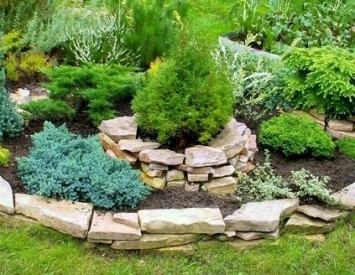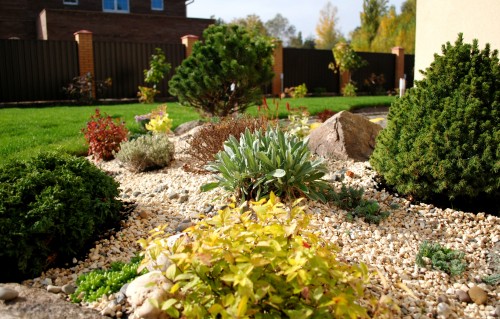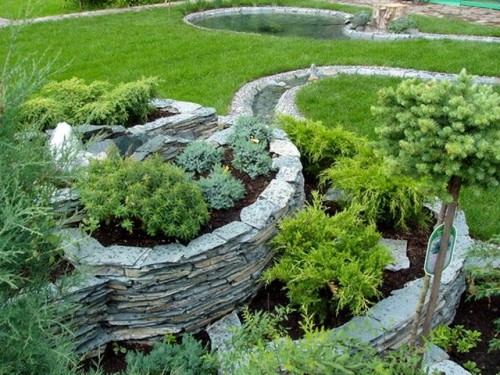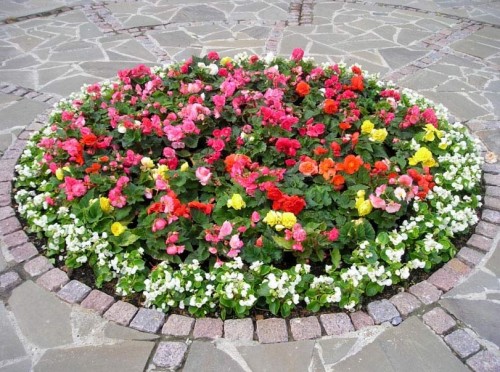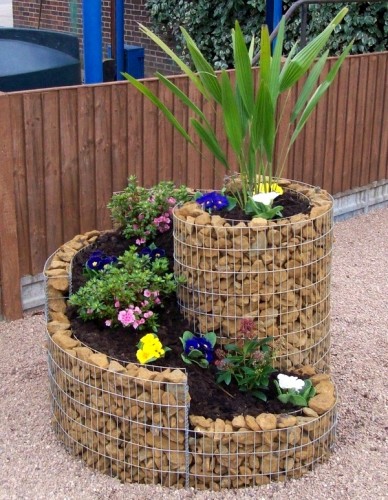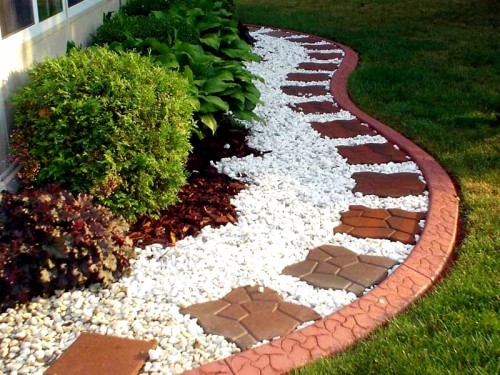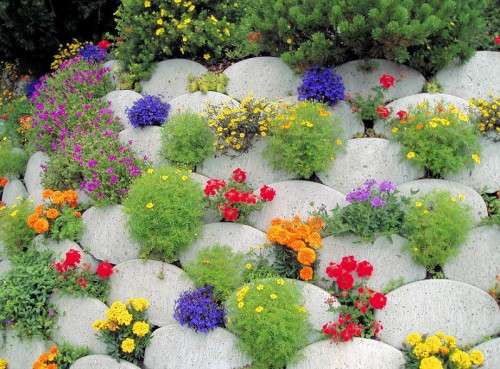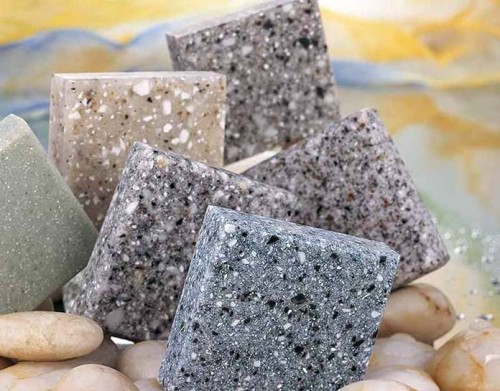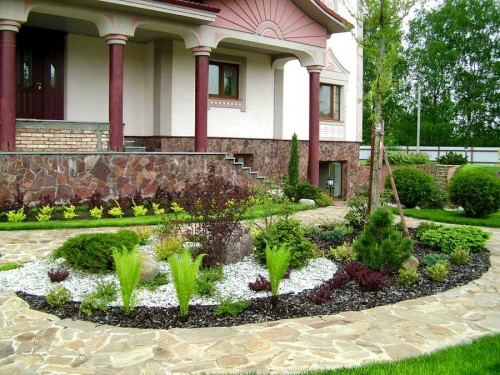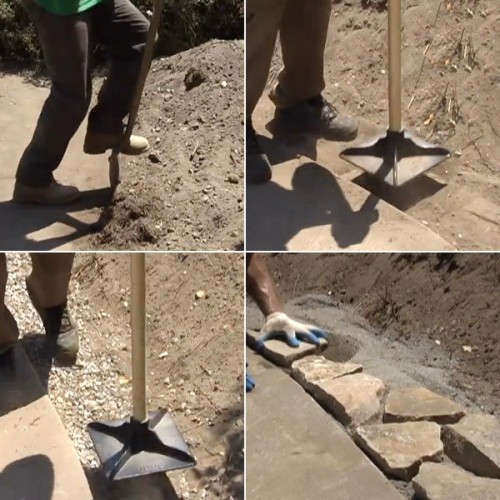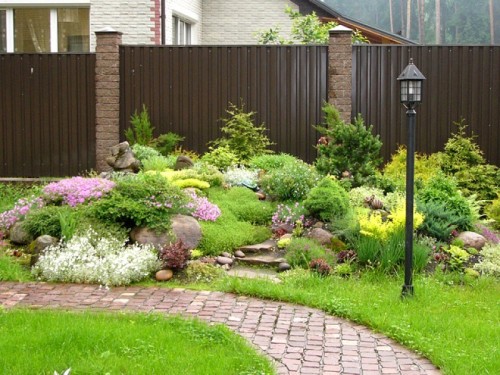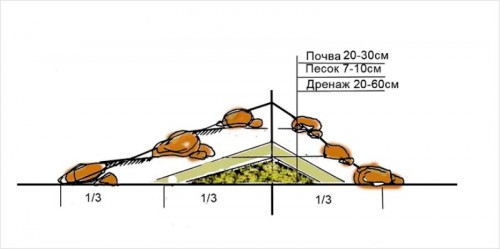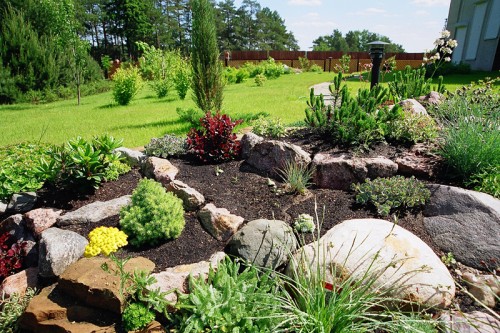Garden territory is the most pleasant place to relax, where you can relax in the shade of trees after a hard day. In order for the site to be well -groomed and neat, many owners equip stone flower beds of various variations. Of course, not everyone will be able to pay for the services of a landscape designer, however, it is completely not difficult to create coziness and a beautiful front garden with your own hands.
Content
Variations of the formation of flower beds
The main requirement before the construction of the flowerbed is the determination of the type of structure and its optimal complexity. Depending on such parameters, the following types of flower beds can be distinguished:
- Irregularflower beds From stones - are used to design a small section of the garden, while not limited to architectural design, forms and look natural. For such flower beds, it is recommended to plant frost -resistant plants, perennial shrubs that can delight the eyes of the owners for the entire country season.
- Multi -level flower garden - The best design option for admirers of non -standard solutions. It is easy to make such stone flower beds with their own hands, they are spectacular and have high aesthetic characteristics. A successful option for forming a flower garden is a construction of several small fragments in a multi -level manner, with various vegetation.
- Monostolnik - This decision is the golden middle between the economical and expensive design of the flowerbed. At the base of the structure, plants of a certain variety are planted, for example, only roses, asters or lilies. And the rest of the space is filled with plants of a different type, forming unusual forms of the flower garden.
- Vertical flowerbed - The option for those who appreciate grace, landscape aesthetics and will not be stolen for its design. Such a flower garden has various shapes, and therefore can be built both in the form of a decorative wall, screen, and in the image of a voluminous figure. At the same time, all vegetation is planted in special containers that should be fixed to the frame.
- Arabesque flower garden - Such a solution will have to like the connoisseurs of original ideas. The flowerbed can be decorated with multi -colored vegetation in the form of various insects, flowers, figures, etc. However, to arrange this type of flower garden, you will need to invest considerable labor and financial costs.
The most common type of flowerbed today is a flower garden, made in the form of a geometric figure and framed by stones. It is quite non -chilly in the creation, easy to operate, but there is an important nuance - all plants should bloom at the same time. Otherwise, its advantages and durability of use contribute to the aesthetic design of the site.
Selecting stones for the arrangement of flower beds
Stone design of a flower garden is a rather practical, budget and original solution. Such material will decorate the flat area, and for its installation it will not be required to add additional concreting and preparing the base. Thanks to this, the visual filling of the site will be neat and the flower bed will not take up much space. Consider the main types of stone that are used to decorate the flower garden:
- Limestone is a natural material with a porous structure that happens in various shades. Mosses grow perfectly on it, and it is also suitable for creating an impromptu container, inside which plants can be planted.
- Sandstone is a fairly simple option for decorating a flower bed made of wild stone. This material has many color solutions and the original texture, it passes the air well and will be able to last in the country for a long time.
- Tuff or travertine is a popular type of limestone. It is suitable for landing ground cover plants that grow along the stone and aesthetically throw it.
- Glutz or Gneis - has the form of a flat stone that can easily be ennobled by the walls of a vertical flowerbed. It has a natural blue, purple or green color, which is in harmony with the common garden landscape.
- Granite - it is permissible to use it as decorative inserts, as it has a acidifying property.
- Galyk - a common material for decorating a flower garden. Stone flower beds in a photo with such a stone are distinguished by accuracy and simplicity in work, due to which you can easily arrange a flower garden on your own.
- Basalt is an original stone that allows you to create unique and diverse effects when decorating a flower bed.
- Dolomite is a rock that is widespread as an articulate stone. It is used for external facing the walls of the flower garden and has a variable color color.
The main requirements for the placement of the flower garden
When building a flower bed on a garden area, it is necessary to take into account some rules for placing and breaking the flower garden. This will create a harmonious and neat composition that will last a long time. The main requirements include the following:
- a stone flowerbed should be located in the central part of the garden or near the wall of the house, so as not to prevent free movement and decorate the territory;
- the selection of vegetation for the flower garden should be carried out taking into account the conditions of the zone where the flowerbed will be located: humidity, illumination, etc.;
- the flowerbed should have good soil content and simple shape;
- to increase the service life, it is recommended to build one large flower garden, instead of several small ones, if this does not recalculate the landscape concept.
Traditional flowerbed: phased instruction
When planning actions how to make a flower bed of stones yourself, it is advisable to take into account a number of factors such as: the type of flower garden, a variety of vegetation, the quality of the soil, the placement of the flower bed on the site and its size. The process of constructing the structure will depend on this. Consider below what actions will allow you to build a neat and simple flower garden.
- On the outer border of the planned flower garden, we drive pegs, limiting its perimeter.
- The inner and outer line must be outlined with chalk or flour.
- With the help of a shovel, you should dig a ditch 300x200 mm.
- In the base of the perimeter, it is necessary to lay out large cobblestones, trying to put them as tightly as possible.
- Each stone from the row should be thoroughly tamped.
- After the stone hedge lay down tightly, we proceed to laying out the 2nd row of stones, while they need to bereflowed as close as possible to each other.
- Place flat cobblestones at the corners of the future flower bed.
- To create your own drainage, the first 5 rows must be laid without a cement mortar.
- After laying the stones, pull the nylon thread, fixing it by the stakes. This will determine the upper boundary of the stone fence.
10. Knead the solution in accordance with the instructions attached to the cement.
11. When the wall will have a height of 15 cm, you can apply concrete dough to the inner surface. This will create the appearance of seamless stone laying.
12. Back the stones with a hammer so that they "sit down" as denser as possible.
13. Leave the stone fence for the 3rd day dry.
14. When the masonry dries, we proceed to the rash of fertile chernozem and planting the necessary vegetation.
The flowerbed is ready. To create an aesthetic look, you can ennoble its decorative mulch. Such a flower garden will give the country area a unique look and harmoniously fit into the design of the garden.
The ideas of the design and construction of the flowerbed can be seen on a fragment:
Alpine slide: step -by -step guide
The most popular type of stone flower bed today is a mountaineering. This type of flower garden is a wild “island” of a mountain landscape, which can be equipped in any garden. In addition, with its help you can successfully disguise the hill, subsequently formed by the disposal of construction waste, etc.
In order to create a neat alpine slide that meets the main requirements of style, you must follow the following instructions:
- Correct placement of climbers is the key to the success of the event. To do this, it is advisable to build a structure in the sunny place of the garden, which will be clearly visible from all sides.
- Then you should correctly choose the vegetation. In the case of an alpine slide, the best option will be low -growing plantations with a small root system. Among the representatives can be distinguished: heather, spicy herbs, cloves, a dashboard, Badan, Edelweiss.
- After choosing the terrain and plants, you can proceed to determine the sizes of the mountaineering. At the same time, it is worth considering the boundaries, shape and bringing of garden paths to the flowerbed.
- Since the alpine slide requires high humidity, it is very important to take care of the drainage layer that can remove the remainder of moisture. To do this, at the site of the facility of the flower garden, you need to dig a ditch with a depth of 50 cm.
- Fill the pit for gravel, brick fragments or gravel.
6. On top of the drainage layer it is necessary to extend the layer of geotextile, on which you need to apply the sand layer, and then the soil layer.
7. On the drainage you can build a mountaineering. There are no strict rules or requirements for its formation, here the main role is assigned to fantasy.
8. Pebbles, shungite, shell -and -grain and granite are optimally suitable as stones.
9. The location of the stones is of great importance, since this affects the strength of the structure. To do this, at the base of the mountaineering, you need to put large cobblestones, and small decorative pebbles are laid out on top of them. When laying stone components, be sure to leave a place for vegetation.
10. Pour the base with fertile soil by 10-15 cm.
11. Start plant planting: perennial shrubs are planted as a priority, then grass, and at the end - flower tubers.
Step -by -step instructions for creating an alpine slide is presented in the video:
